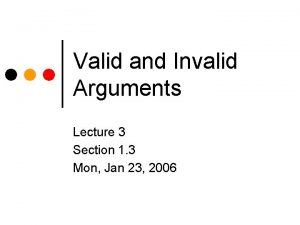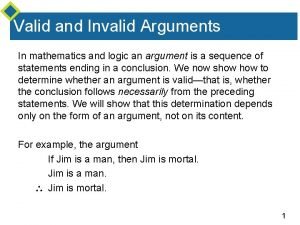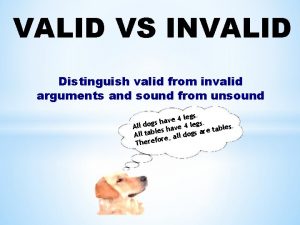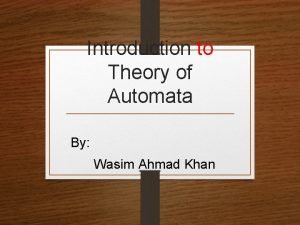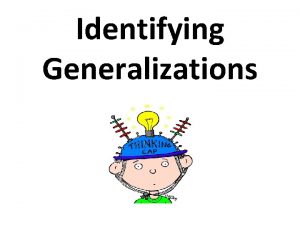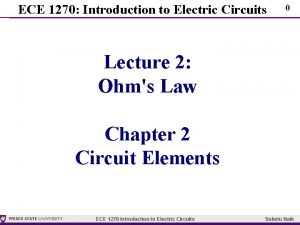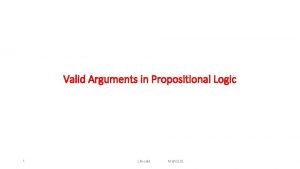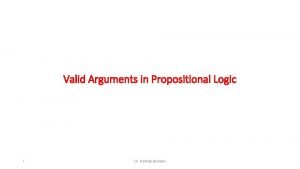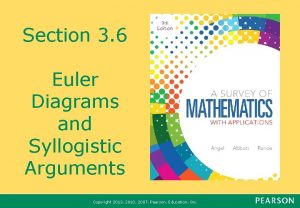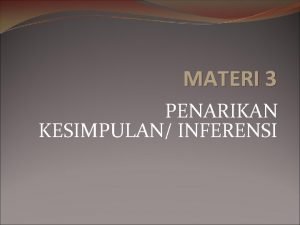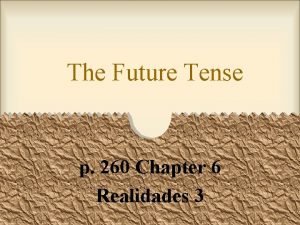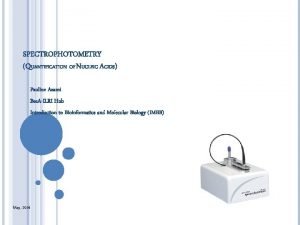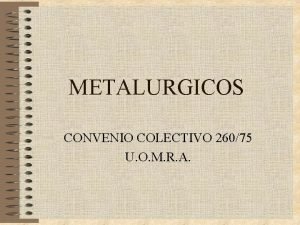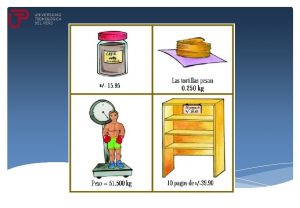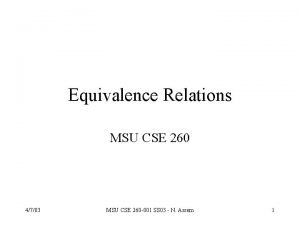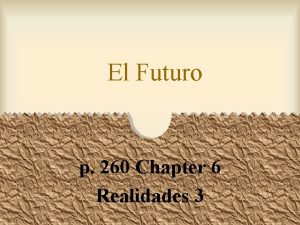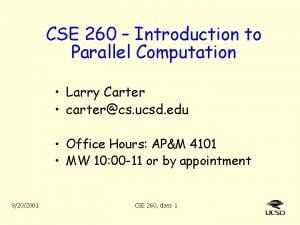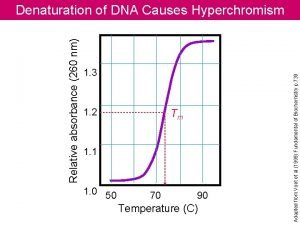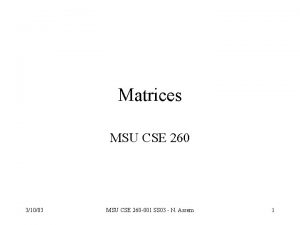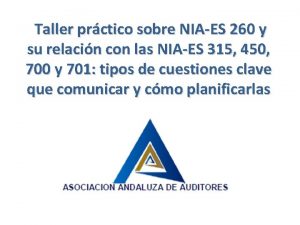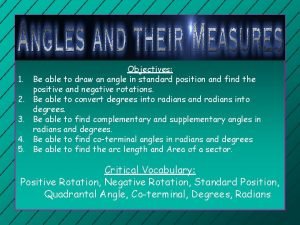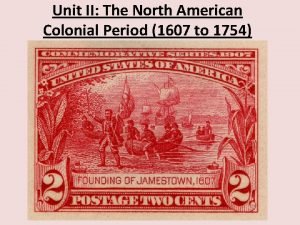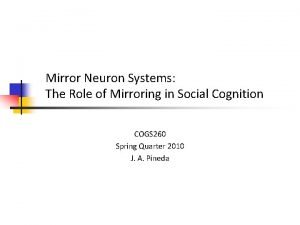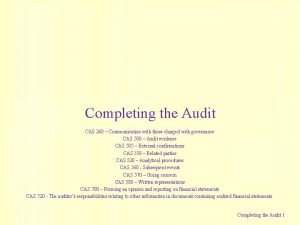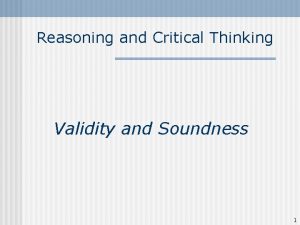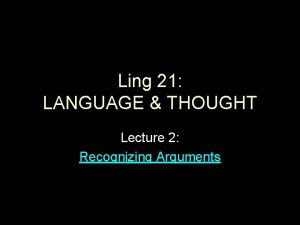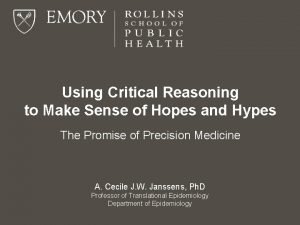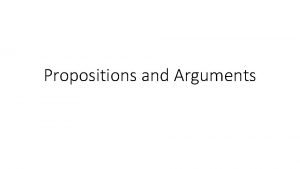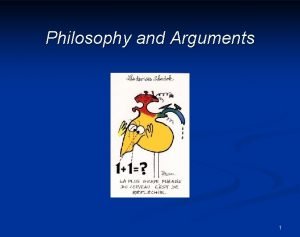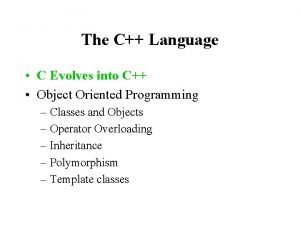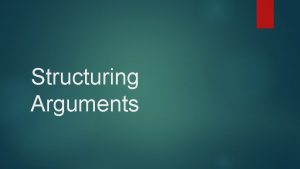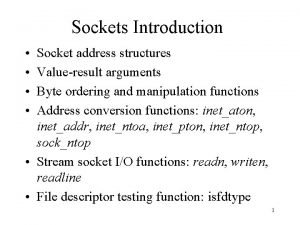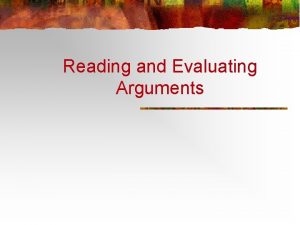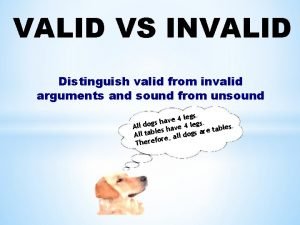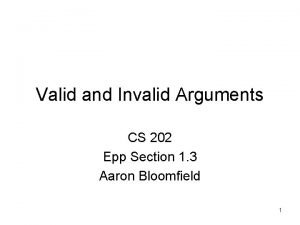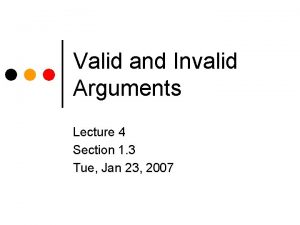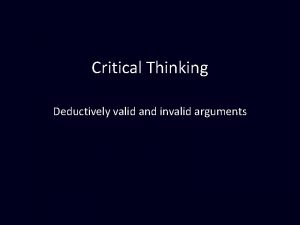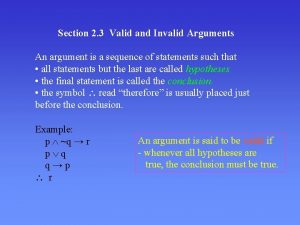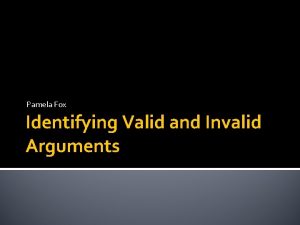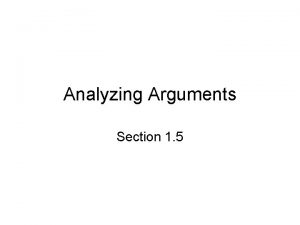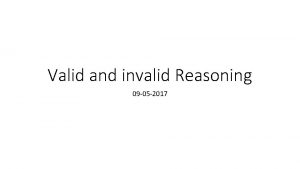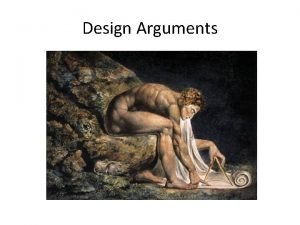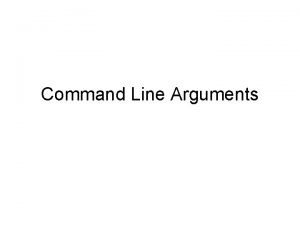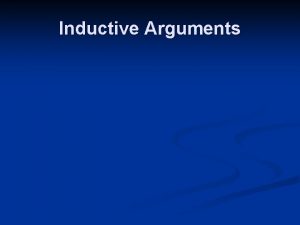Valid and Invalid Arguments M 260 2 3






















































- Slides: 54

Valid and Invalid Arguments M 260 2. 3

Argument • An argument is a sequence of statements. The final statement is called the conclusion, the others are called the premises. • = “therefore” before the conclusion.

Logical Form • If Socrates is a human being, then Socrates is mortal; Socrates is a human being; Socrates is mortal. • If p then q; p; q

Valid Argument • An argument form is valid means no matter what particular statements are substituted for the statement variables, if the resulting premises are all true, then the conclusion is also true. • An argument is valid if its form is valid.

Test for Validity • Identify premises and conclusion • Construct a truth table including all premises and conclusion • Find rows with premises true (critical rows) • If conclusion is true on all critical rows, argument is valid • Otherwise argument is invalid

Argument Validity Test Example 1 • p (q r) • ~r • p q

premises p q r TTT TTF TFT TFF FTT FTF FFT FFF q r p (q r) ~r conclusion p q

premises conclusion p q r p (q r) ~r p q TTT T T F T TTF T T TFT T T F T TFF F T T T FTT T T FTF T T FFT T T F F FFF F F T F

premises conclusion p q r p (q r) ~r p q TTT T T F T TTF T T TFT T T F T TFF F T T T FTT T T FTF T T FFT T T F F FFF F F T F

Argument Validity Test Example 2 • p q ~r • q p r • p r

premises p q r TTT TTF TFT TFF FTT FTF FFT FFF ~r q ~r p q ~r q p r conclusion p r

premises conclusion p q r ~r q ~r p q ~r q p r TTT F T T TTF T T F F TFT F F T T TFF T T F FTT F T F T FTF T T F T FFT F F F T T T FFF T T T

premises conclusion p q r ~r q ~r p q ~r q p r TTT F T T TTF T T F F TFT F F T T TFF T T F FTT F T F T FTF T T F T FFT F F F T T T FFF T T T

Rules of Inference (Valid Argument Forms) • • Modus Ponens Modus Tolens Generalization Specialization • • Elimination Transitivity Division into Cases Rule of Contradiction

Modus Ponens • If p then q; • p; • q

Modus Ponens premises p q T T T F F p q conclusion p q

Modus Ponens premises conclusion p q p q T T T F F T F F

Modus Ponens premises conclusion p q p q T T T F F T F F

Modus Ponens Example • If the last digit of this number is 0, then the number is divisible by 10. • The last digit of this number is a 0. • This number is divisible by 10.

Modus Tollens • If p then q; • ~q; • ~p

Modus Tollens premises p q T T T F F p q conclusion ~q ~p

Modus Tollens premises conclusion p q ~q ~p T T T F F T T F F T T T

Modus Tollens premises conclusion p q ~q ~p T T T F F T T F F T T T

Modus Tollens Example • If Zeus is human, then Zeus is mortal. • Zeus is not mortal. • Zeus is not human • Modus tollens uses the contrapositive.

Generalization • p • p q • q • p q

Specialization • p q • p • p q • q

Elimination • p q • ~q • p • p q • ~p • q

Transitivity • p q • q r • p r

Division into Cases • • p q p r q r r

Division into Cases Example • • x>1 or x<-1 If x>1 then x 2>1 If x<-1 then x 2>1

Valid Inference Example Statements a, b, c. • a. If my glasses are on the kitchen table, then I saw them at breakfast. • b. I was reading the newspaper in the living room or I was reading the newspaper in the kitchen. • c. If I was reading the newspaper in the living room, then my glasses are on the coffee table.

Valid Inference Example Statements a, b, c. • a. If my glasses are on the kitchen table, then I saw them at breakfast. • b. I was reading the newspaper in the living room or I was reading the newspaper in the kitchen. • c. If I was reading the newspaper in the living room, then my glasses are on the coffee table.

Valid Inference Example Symbols p, q, r, s, t. • p = My glasses are on the kitchen table. • q = I saw my glasses at breakfast. • r = I was reading the newspaper in the living room • s = I was reading the newspaper in the kitchen. • t = My glasses are on the coffee table.

Statements a, b, c in Symbols • a. p q • b. r s • c. r t

Valid Inference Example Statements d, e, f. • d. I did not see my glasses at breakfast. • e. If I was reading my book in bed, then my glasses are on the bed table. • f. If I was reading the newspaper in the kitchen, then my glasses are on the kitchen table.

Valid Inference Example Statements d, e, f. • d. I did not see my glasses at breakfast. • e. If I was reading my book in bed, then my glasses are on the bed table. • f. If I was reading the newspaper in the kitchen, then my glasses are on the kitchen table.

Valid Inference Example Symbols u, v. • u =I was reading my book in bed. • v = My glasses are on the bed table.

Statements d, e, f in Symbols • d. ~q • e. u v • f. s p

Inference Example Givens • a. p q • b. r s • c. r t • d. ~q • e. u v • f. s p

Deduction Sequence • 1. p q ~q ~p • 2. s p ~p ~s from ( ) by _____ from ( ) by_____

Deduction Sequence • 1. p q ~q ~p • 2. s p ~p ~s from (a) from (d) by modus tollens from (f) from (1) by modus tollens

Deduction Sequence • 3. r s ~s r • 4. r t r t from ( ) by_____________

Deduction Sequence • 3. r s ~s r • 4. r t r t from (b) from (2) by disjunctive syllogism from (c) from (3) by modus ponens

Errors in Reasoning • • • Using vague or ambiguous premises. Circular reasoning Jumping to conclusions Converse error Inverse error

Converse Error • If Zeke is a cheater, then Zeke sits in the back row. Zeke is a cheater. • p q q p

Inverse Error • If interest rates are going up, then stock market prices will go down. Interest rates are not going up Stock market prices will not go down. • p q ~p ~q

Inverse Error • If I intend to sell my house, then I will need a permit for this wall. I do not intend to sell my house. I do not need a permit for this wall. • p q ~p ~q

Validity vs. Truth • Valid arguments can have false conclusions if one of the premises is false. • Invalid arguments can have true conclusions.

Valid but False • If John Lennon was a rock star then John Lennon had red hair. • John Lennon was a rock star. • John Lennon had red hair.

Invalid but True • If New York is a big city, then New York has tall buildings. • New York is a big city.

Contradiction Rule • If the supposition that p is false leads to a contradiction then p is true. • ~p c, where c is a contradiction. p

Contradiction Rule • If the supposition that p is false leads to a contradiction then p is true. • ~p c, where c is a contradiction. p p T F ~p F T c F F premise conclusion ~p c p T T F F

Rule of Contradiction Example • • Knights tell the truth, Knaves lie. A says: “B is a knight. ” B says: “A and I are opposite types. ” What are A and B? • (Hint: Suppose A is a Knight. )

Rules of Inference (Valid Argument Forms) • • Modus Ponens Modus Tolens Disjunctive Addition Conjunctive Simplification • Disjunctive Syllogism • Hypothetical Syllogism • Division into Cases • Rule of Contradiction
 Invalid arguments examples
Invalid arguments examples False premise example
False premise example Sound vs unsound arguments
Sound vs unsound arguments Valid and invalid alphabets in automata
Valid and invalid alphabets in automata Generalization paragraph examples
Generalization paragraph examples Valid and invalid circuits
Valid and invalid circuits Valid
Valid Valid arguments in propositional logic
Valid arguments in propositional logic Arguments and euler diagrams
Arguments and euler diagrams Contoh modus ponens
Contoh modus ponens Tendre future tense
Tendre future tense 260/280 ratio
260/280 ratio Cct 260/75
Cct 260/75 Dos cajas de galletas contienen en total 260 galletas
Dos cajas de galletas contienen en total 260 galletas Cse 260 msu
Cse 260 msu Realidades 3 capitulo 6 el futuro (p. 260)
Realidades 3 capitulo 6 el futuro (p. 260) Ed 260
Ed 260 Cse 260
Cse 260 Chem 260 umich
Chem 260 umich 260 ucas points
260 ucas points Relative absorbance
Relative absorbance Cse 260 msu
Cse 260 msu Reishauer rz 260
Reishauer rz 260 Si9a
Si9a Act 5 summary hamlet
Act 5 summary hamlet 860 en yakın yüzlüğe yuvarlama
860 en yakın yüzlüğe yuvarlama Hamlet act 5 scene 1 line 260
Hamlet act 5 scene 1 line 260 Bio 260
Bio 260 260 degrees in standard position
260 degrees in standard position 300000/260
300000/260 Msu cse 260
Msu cse 260 260 000 000
260 000 000 Mirror neurons location
Mirror neurons location 44 word form
44 word form Cea.cas700.com
Cea.cas700.com What is at the root of most arguments and many fights?
What is at the root of most arguments and many fights? False premise example
False premise example Arguments and explanations
Arguments and explanations Examples of sound and unsound arguments
Examples of sound and unsound arguments Examples of sound and unsound arguments
Examples of sound and unsound arguments Statements and arguments
Statements and arguments What is reasoning
What is reasoning Gimpose
Gimpose Propositions and arguments
Propositions and arguments Structure of a deductive argument
Structure of a deductive argument Invalid and unsound argument examples
Invalid and unsound argument examples Valid percent چیست
Valid percent چیست Example of emotivism
Example of emotivism Default arguments
Default arguments Structuring arguments
Structuring arguments Value result arguments
Value result arguments Arguments of evaluation
Arguments of evaluation What is an enthymeme example
What is an enthymeme example Ontological philosophy
Ontological philosophy Diagram ontological argument
Diagram ontological argument
